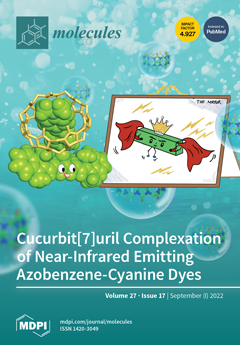Pelargonium graveolens leaves are widely used in traditional medicine for relieving some cardiovascular, dental, gastrointestinal, and respiratory disorders. They are also used as food and tea additives in Palestine and many other countries. Consequently, this investigation aimed to describe the chemical markers, cytotoxic,
[...] Read more.
Pelargonium graveolens leaves are widely used in traditional medicine for relieving some cardiovascular, dental, gastrointestinal, and respiratory disorders. They are also used as food and tea additives in Palestine and many other countries. Consequently, this investigation aimed to describe the chemical markers, cytotoxic, antioxidant, antimicrobial, metabolic, and cyclooxygenase (COX) enzymes inhibitory characteristics of
P. graveolens essential oil (PGEO) from Palestine utilizing reference methods. There were 70 chemicals found in the GCMS analysis, and oxygenated terpenoids were the most abundant group of the total PGEO. Citronellol (24.44%), citronellyl formate (15.63%),
γ-eudesmol (7.60%), and iso-menthone (7.66%) were the dominant chemical markers. The EO displayed strong antioxidant activity (IC
50 = 3.88 ± 0.45 µg/mL) and weak lipase and α-amylase suppressant effects. Notably, the PGEO displayed high α-glucosidase inhibitory efficacy compared with Acarbose, with IC
50 doses of 52.44 ± 0.29 and 37.15 ± 0.33 µg/mL, respectively. PGEO remarkably repressed the growth of methicillin-resistant
Staphylococcus aureus (MRSA), even more than Ampicillin and Ciprofloxacin, and strongly inhibited
Candida albicans compared with Fluconazole. The highest cytotoxic effect of the PGEO was noticed against MCF-7, followed by Hep3B and HeLa cancer cells, with IC
50 doses of 32.71 ± 1.25, 40.71 ± 1.89, and 315.19 ± 20.5 µg/mL, respectively, compared with doxorubicin. Moreover, the screened EO demonstrated selective inhibitory activity against COX-1 (IC
50 = 14.03 µg/mL). Additionally, PGEO showed a weak suppressant effect on COX-2 (IC
50 = 275.97 µg/mL). The current research can be considered the most comprehensive investigation of the chemical and pharmacological characterization of the PGEO. The results obtained in this study demonstrate, without doubt, that this plant represents a rich source of bioactive substances that can be further investigated and authenticated for their medicinal potential.
Full article






